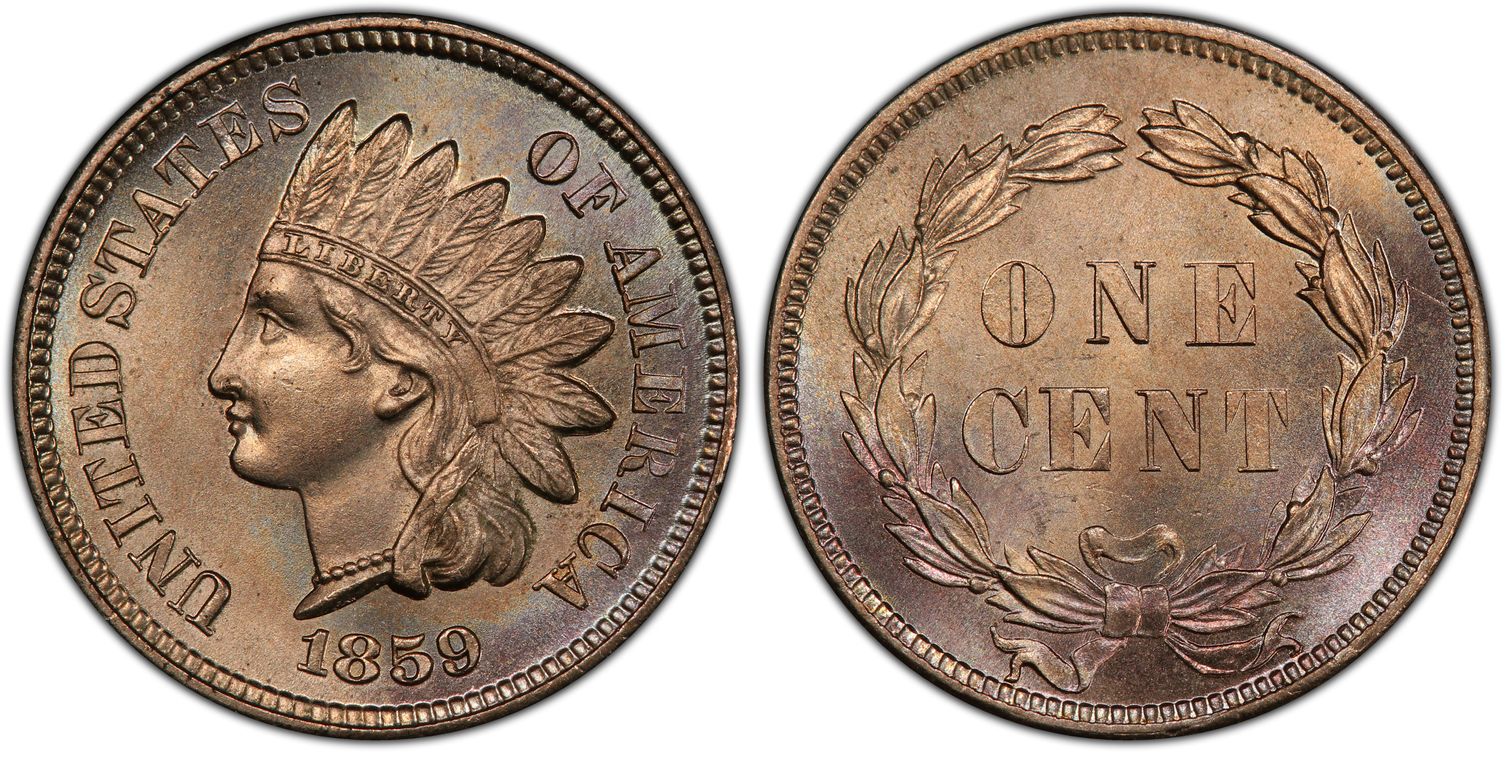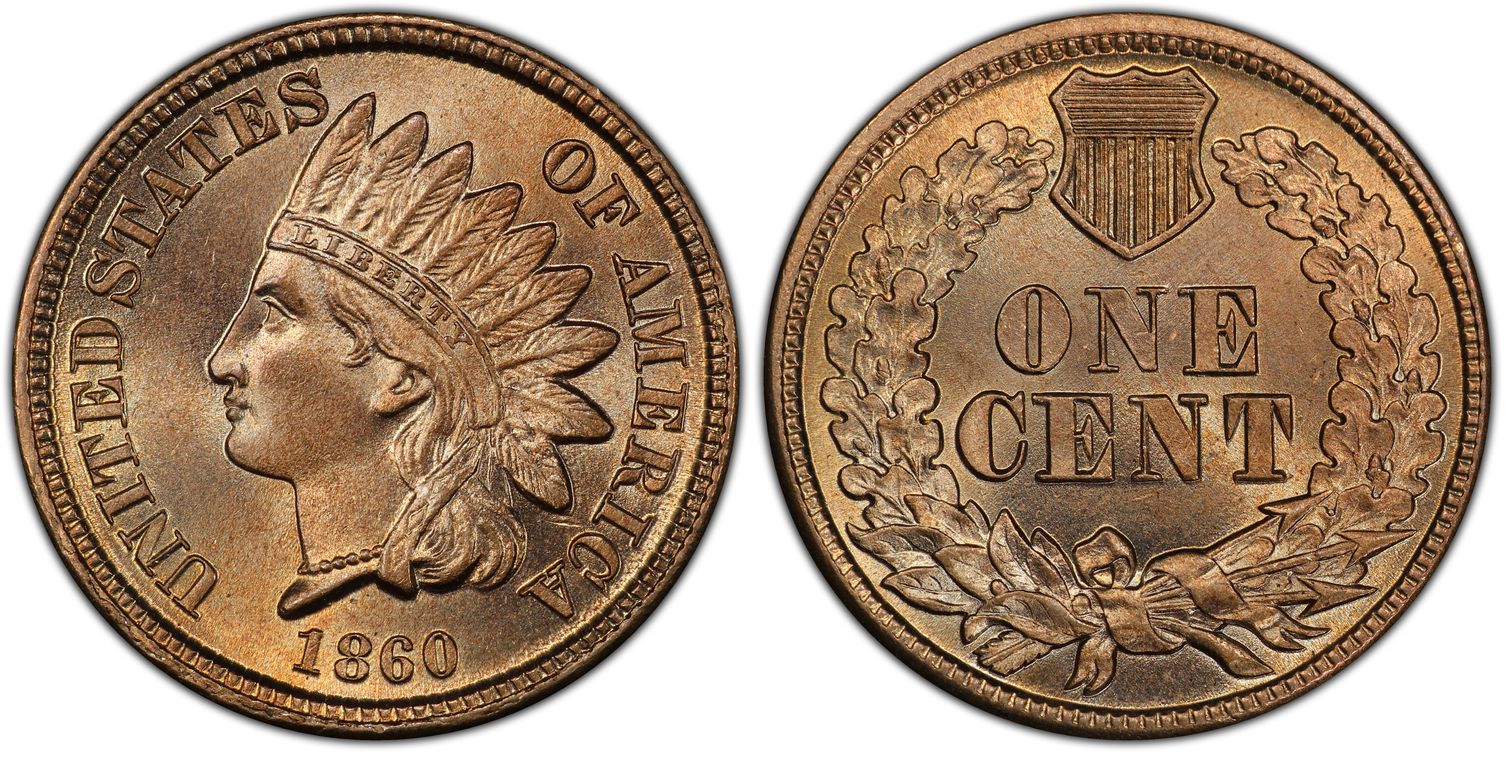Indian Head Cent (1859–1909): Values, Varieties, and Rarities
The Indian Head Cent is one of the most popular coins to collect, surpassed only by the Morgan Dollar. They have been popular from the start. The Indian Head penny replaced the 1857–1858 Flying Eagle Cent, possibly because it was difficult to get a full strike from the design.
Indian Head Cents were minted from 1859 to 1909. The “Indian” on the obverse of the coin was actually Lady Liberty in a stylized Native American headdress. This obverse design would remain unchanged throughout the coin’s history.
RD, RB, BN Indian Cents: What Do They Mean?
Cents are not only graded by condition but also by how much of their original color remains. There are three classifications: Brown (BN), Red-Brown (RB), and Red (RD).

1891 Indian Head Cents graded BN, RB, and RD (PCGS)
These definitions are more subjective than the physical grades laid out in the 1–70 coin grading scale.
Circulated cents and uncirculated ones exposed to air develop a brown, sometimes chocolatey color. All things being equal, cents graded BN are far less desirable to collectors than RB or RD coins. (Note: the prices in this guide are for BN coins, as these are the most common.)
Red-brown cents have a good portion of their original luster remaining. The exact amount of red remaining for a coin to be considered RB can differ among grading services. Some collectors find that certain RB cents can have more eye appeal than a “better” RD coin of the same condition grade.
Red coins have almost all their original luster present. For older cents, this is usually only possible for new coins kept in rolls or airtight containers or from unopened Mint Sets.
Type 1 Indian Head Cent Prices (1859)
The Type 1 Indian Head Cent was only struck for one year: 1859. Because this was the first mintage of a new design and a single-year design at that, many of them were saved. This is also why the 1859 Indian Cent is so popular among collectors today.
The reverse of the 1859 Indian Head Cent had a wreath surrounding the words ONE CENT. The reverse changed in 1860 to feature a thicker wreath separated at the top by a Union Shield to create the Type 2 Indian Head Cent. The 1859 and 1860–1864 Indian Head Cent struck from the same 88% copper and 12% nickel alloy.
1859 Indian Head Cent (Type 1). Graded MS66+ by PCGS
1859 Indian Cent Value
Type 2 Indian Head Cent Prices (1860–1864)
The Type 2 Indian Head Cent retained the 88% copper 12% nickel composition of the 1859 Indian Head and the Flying Eagle Cent before that. The nickel content gave the Type 1 and Type 2 Indian Heads a lighter color than pure copper coins, giving them the nickname “white cents.”
The 1860 Indian Head cent introduced a new reverse design of a thicker wreath (changing from laurel to oak) separated by a Union Shield. These obverse and reverse designs remained the standard for the series throughout the rest of its run.

1860 Indian Head Cent (Type 2). Graded MS67+ by PCGS.
Also in the Type 2 design, introduced late in the second year of production of the Indian Cent series, the obverse used a rounded bustline rather than a pointed one. This made Pointed Bust pennies rarer than the Rounded Bust type, which you can check prices for in the section below.
1860–1864 Indian Head Cent Value
Type 3 Indian Head Cent Prices (1864–1909)
At some point during 1864, the US Mint changed the composition of the Indian Head Cent from 88% copper and 12% nickel to a bronze alloy of 95% copper and a 5% mixture of tin and zinc. Apparently, copper prices had gone down. This bronze alloy made it much easier to get a full strike compared to the copper-nickel alloy that came before.
1868 Indian Head Cent (Type 3). Graded MS64 by PCGS
Type 3 Indian Cent Value
Major Indian Head Cent Varieties
There are too many varieties over the 50 years of Indian Head Cents to list here, but here are the most notable ones:
1860 Pointed Bust Indian Head Cent
The Pointed Bust Indian Head Cent was the original design of the coin. Part-way through the year, the obverse design was replaced by one that had a blunter edge to the bustline. Pointed Bust Indian Cents are much rarer than the Rounded Bust.
1861 Repunched Date (RPD) Indian Head Cent
The 1861 Indian Head Cent originally had what looks like a sans-serif 1 in the last digit of the date. This was repunched with the proper design, which ended up slightly higher than the offending digit.
1864 “L on Ribbon” Indian Head Cent
The 1864 Indian Bronze (Type 3) Indian Head Cent was the first mintage to have the L initial of the artist James Longacre, who was Chief Engraver of the US Mint from 1844 to 1869. The “L on Ribbon” Indian Cent is one of the most popular coins in the series, with prices reflecting that demand.
1867/67 Repunched Date (RPD) Indian Head Cent
The 1867/67 Indian penny is a rare mintage that has a dramatic repunch of the last two digits of the date. The repunched digits are prominent enough to be seen with the naked eye without needing to hunt for it.
1873 “Doubled Liberty” DDO Indian Head Cent
The 1873 Indian Head Cent DDO is better known as the “Doubled Liberty” DDO. While the die doubling is easily seen on Liberty’s nose and eye, it is the extremely strong doubling of the word “LIBERTY” on the headdress that is most obvious.
1888/7 Repunched Date (RPD) Indian Head Cent
The 1888/7 Indian Cent RPD is a popular variety that is not immediately obvious. The date was originally punched as 1887 before the 7 was overpunched by an 8. Most of the examples were found in circulation before the mistake was widely known. This means that an unknown number of this variety had the error worn away before collectors started looking for them.
1894/1894 Repunched Date (RPD) Indian Head Cent
The 1894/1894 Indian Head penny has the entire date repunched. This is most dramatic on Mint State coins, where the pieces of the underdate, especially the top of the 4, make a spectacular sight.
Read more about penny prices and collecting coins from the Gainesville Coins experts:
1905 Indian Head Penny Values, Errors, and Rarities
1909-S VDB Penny Values, Varieties, and Rarities
1909 VDB Penny Value, Errors, and Varieties
1912-S Penny Values, Errors, and Rarities
1943 Steel Penny Value: How Much They Are Worth Now
1964 Lincoln Penny Values, Errors, and Rarities
1968 Lincoln Penny Values, Errors, and Rarities
1969 Lincoln Penny Values, Errors, and Rarities
2009 Lincoln Penny Bicentennial Cents: Value, Errors, and Designs

Steven Cochran
A published writer, Steven's coverage of precious metals goes beyond the daily news to explain how ancillary factors affect the market.
Steven specializes in market analysis with an emphasis on stocks, corporate bonds, and government debt.







